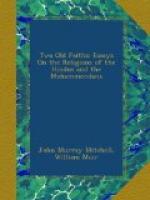[Sidenote: New deities, rites, and customs.] The worship of the Linga (phallus) has been introduced. So has the great dogma of Transmigration, which has stamped a deeper impress on later Hindu mind than almost any other doctrine. Caste is fully established, though in Vedic days scarcely, if at all, recognized. The dreadful practice of widow-burning has been brought in, and this by a most daring perversion of the Vedic texts. Woman, in fact, has fallen far below the position assigned her in early days.
[Sidenote: The Trimurtti, a triad of gods.] One of the notable things in connection with the reconstruction of Hinduism is the position it gives to the Trimurtti, or triad of gods—Brahma, Vishnu, and Siva. Something like an anticipation of this has been presented in the later Vedic times: fire, air, and the sun (Agni, Vayu, and Surya) being regarded by the commentator[24] as summing up the divine energies. But in the Vedas the deities often go in pairs; and little stress should be laid on the idea of a Vedic triad. That idea, however, came prominently forward in later days. The worship both of Vishnu and Siva may have existed, from ancient times, as popular rites not acknowledged by the Brahmans; but both of these deities were now fully recognized. The god Brahma was an invention of the Brahmans; he was no real divinity of the people, and had hardly ever been actually worshiped. It is visual to designate Brahma, Vishnu, and Siva as Creator, Preserver, and Destroyer respectively; but the generalization is by no means well maintained in the Hindu books.
[Sidenote: The Avatara.] The Puranas are in general violently sectarian; some being Vishnuite, others Sivite. It is in connection with Vishnu, especially, that the idea of incarnation becomes prominent. The Hindu term is Avatara, literally, descent; the deity is represented as descending from heaven to earth, for vindication of the truth and righteousness, or, to use the words ascribed to Krishna,
For the preservation
of the good, and the destruction of the wicked,
For the establishment
of religion, I am born from age to age.
[Sidenote: The “descents” of Vishnu.] The “descents” of Vishnu are usually reckoned ten. Of these by far the most celebrated are those of Rama and Krishna. The great importance attached to these two deities has been traced to the influence of Buddhism. That system had exerted immense power in consequence of the gentle and attractive character ascribed to Buddha. The older gods were dim, distant, and often stern; some near, intelligible, and loving divinity was longed for. Buddha was a brother-man, and yet a quasi-deity; and hearts longing for sympathy and succor were strongly attracted by such a personality.




